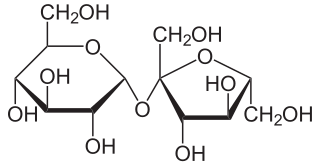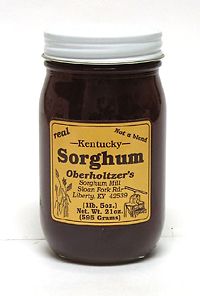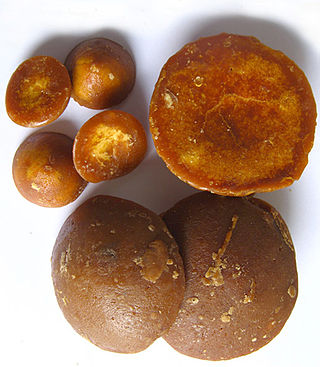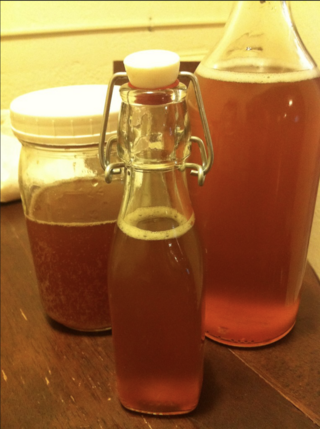
Sugar is the generic name for sweet-tasting, soluble carbohydrates, many of which are used in food. Simple sugars, also called monosaccharides, include glucose, fructose, and galactose. Compound sugars, also called disaccharides or double sugars, are molecules made of two bonded monosaccharides; common examples are sucrose, lactose, and maltose. White sugar is a refined form of sucrose. In the body, compound sugars are hydrolysed into simple sugars.
A sweetener is a substance added to food or drink to impart the flavor of sweetness, either because it contains a type of sugar, or because it contains a sweet-tasting sugar substitute. Various natural non-sugar sweeteners and artificial sweeteners are used to produced food and drink.

Sucrose, a disaccharide, is a sugar composed of glucose and fructose subunits. It is produced naturally in plants and is the main constituent of white sugar. It has the molecular formula C
12H
22O
11.

Molasses is a viscous substance, principally obtained from the refining of sugarcane, or sugar beet juice into sugar. Molasses varies in the amount of sugar, the method of extraction and the age of the plant. Sugarcane molasses is usually used to sweeten and flavour foods. Molasses is a major constituent of fine commercial brown sugar. It is also one of the main ingredients used to distill rum.

Maple sugar is a traditional sweetener in Canada and the northeastern United States, prepared from the sap of the maple tree.

In cooking, syrup is a condiment that is a thick, viscous liquid consisting primarily of a solution of sugar in water, containing a large amount of dissolved sugars but showing little tendency to deposit crystals. Its consistency is similar to that of molasses. The viscosity arises from the multiple hydrogen bonds between the dissolved sugar, which has many hydroxyl (OH) groups.

Jaggery is a traditional non-centrifugal cane sugar consumed in the Indian Subcontinent, Southeast Asia, Central América, Brazil and Africa. It is a concentrated product of cane juice and often date or palm sap without separation of the molasses and crystals, and can vary from golden brown to dark brown in colour. It contains up to 50% sucrose, up to 20% invert sugars, and up to 20% moisture, with the remainder made up of other insoluble matter, such as wood ash, proteins, and bagasse fibres. Jaggery is very similar to muscovado, an important sweetener in Portuguese, British and French cuisine. The Kenyan Sukari ngutu/nguru has no fibre; it is dark and is made from sugar cane and also sometimes extracted from palm tree.

Sweet sorghum is any of the many varieties of the sorghum grass whose stalks have a high sugar content. Sweet sorghum thrives better under drier and warmer conditions than many other crops and is grown primarily for forage, silage, and syrup production.

Golden syrup or light treacle is a thick, amber-coloured form of inverted sugar syrup made by the process of refining sugar cane or sugar beet juice into sugar. It is used in a variety of baking recipes and desserts. It has an appearance and consistency similar to honey, and is often used as a substitute where honey is unavailable.

Palm sugar is a sweetener derived from any variety of palm tree. Palm sugar is sometimes qualified by the type of palm, as in coconut palm sugar. While sugars from different palms may have slightly different compositions, all are processed similarly and can be used interchangeably.

Agave syrup, also known as maguey syrup or agave nectar, is a sweetener commercially produced from several species of agave, including Agave tequilana and Agave salmiana. Blue-agave syrup contains 56% fructose as a sugar providing sweetening properties.
Steen's cane syrup is a traditional American sweetener made by the simple concentration of cane juice through long cooking in open kettles. The result is a dark, "caramel–flavored, burnt gold–colored syrup," "deep and slightly sulfurous" with a "lightly bitter backlash." It is sweeter than molasses because no refined sugar is removed from the product.

Coconut sugar is a palm sugar produced from the sap of the flower bud stem of the coconut palm.

Palm syrup is an edible sweet syrup produced from the sap of a number of palms. It is produced in the Canary Islands and coastal regions of South America.

Grape syrup is a condiment made with concentrated grape juice. It is thick and sweet because of its high ratio of sugar to water. Grape syrup is made by boiling grapes, removing their skins, squeezing them through a sieve to extract the juice. Like other fruit syrups, a common use of grape syrup is as a topping to sweet cakes, such as pancakes or waffles.

Pekmez is a molasses-like syrup obtained after condensing juices of fruit must, especially grape by boiling it with a coagulant agent like wood ashes or ground carob seeds. It is used as a syrup or mixed with tahini for breakfast. In Azerbaijan, pekmez is also mixed with natural yogurt and consumed as a refreshment during summer time.

Cider syrup is also known as apple molasses. It is a fruit syrup concentrated from apple cider, first made in colonial America. It is a thick, dark brown, opaque syrup with concentrated apple flavor. The color is darker than honey and its flavor more tart than maple syrup. A syrup-like product has a much longer shelf-life than the fresh fruit, thereby extending the apple harvest's contribution to diets throughout the year.

















